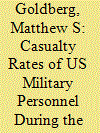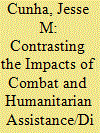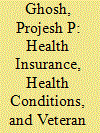|
|
|
Sort Order |
|
|
|
Items / Page
|
|
|
|
|
|
|
| Srl | Item |
| 1 |
ID:
160091


|
|
|
|
|
| Summary/Abstract |
The Military Compensation and Retirement Modernization Commission was established by the Congress in 2013 to perform a systematic review of military compensation to address rising costs and other trends. Their recommendation for reforming the TRICARE health care program was sweeping, and differed greatly from earlier proposals that focused on increasing beneficiary cost shares. Specifically, the commission proposed overhauling the current benefit delivery model and replacing it with a premium-based insurance model offering a menu of DoD-sponsored private health plans. The analysis presented here is based on work that supported the commission by estimating the budgetary impact of its proposed reforms. Results indicate that movement towards the premium-based model would produce an annual budgetary cost savings in the $2 billion to $4 billion range, with a best savings estimate of $3.2 billion.
|
|
|
|
|
|
|
|
|
|
|
|
|
|
|
|
| 2 |
ID:
160093


|
|
|
|
|
| Summary/Abstract |
In Operation Iraqi Freedom, which ended in August 2010, nearly 3500 hostile deaths occurred among US military personnel and 32,000 more were wounded in action (WIA). More than 1800 hostile deaths occurred during Operation Enduring Freedom (in and around Afghanistan) through 2014 and about 20,000 were WIA. A larger proportion of wounded personnel survived in Iraq and Afghanistan than during the Vietnam War, but the increased survival rates were not as high as some studies have asserted. The survival rates were 90.2% in Iraq and 91.6% in Afghanistan, compared with 86.5% in Vietnam. The casualty rates varied between the conflicts in Iraq and Afghanistan and before, during, and after the respective surges. Amputation rates are difficult to measure consistently, but I estimate that 2.6% of all WIA and 9.0% of medically evacuated WIA from the Iraq and Afghanistan theaters combined resulted in the major loss of a limb. Elevated non-hostile death rates (including deaths due to accidents, illnesses, homicides, or suicides) resulted in about 220 more deaths in Iraq and about 200 more deaths in Afghanistan than would have been expected in peacetime among populations of the size deployed to those two conflicts.
|
|
|
|
|
|
|
|
|
|
|
|
|
|
|
|
| 3 |
ID:
160095


|
|
|
|
|
| Summary/Abstract |
Insomnia is prevalent among Veterans with post-traumatic stress disorder (PTSD), it exacerbates PTSD symptoms, and it contributes to impaired functioning and quality of life. To improve treatment outcomes, it is important to identify risk factors for insomnia and sedative-hypnotic use. Classification and regression trees and logistic regression models were used to identify variables associated with insomnia or sedative-hypnotic use. Key findings include low insomnia diagnosis rates (3.5–5.6%) and high rates of sedative-hypnotics (44.2–49.0%). Younger Veterans and those without a breathing-related sleep disorder (BRSD) were more likely to receive an insomnia diagnosis. Veterans with greater service connection and those with an alcohol/substance use disorder were more likely to be prescribed sedative-hypnotics. Interaction terms may have identified potential groups at risk of being under-diagnosed with insomnia (i.e. non-black Veterans with psychiatric co-morbidity, black Veterans without psychiatric co-morbidity) as well as groups at risk for sedative-hypnotic use (i.e. younger Veterans without BRSD). In sum, Veterans with PTSD have high rates of sedative-hypnotic use despite minimal evidence they are effective. This is counter to recommendations indicating behavioral interventions are the first-line treatment. Policy changes are needed to reduce use of sedative-hypnotics and increase access to behavioral insomnia interventions.
|
|
|
|
|
|
|
|
|
|
|
|
|
|
|
|
| 4 |
ID:
160094


|
|
|
|
|
| Summary/Abstract |
We study the differential impacts of combat and humanitarian assistance/disaster relief (HA/DR) missions on the mental health of U.S. Marine Corps members. The deployment experiences of any individual Marine are plausibly random conditional on the observable characteristics which are used to assign Marines into units. Leveraging this exogenous variation, we compare the incidence of post-traumatic stress disorder (PTSD) and suicide deaths among Marines who deployed to either Operation Enduring Freedom/Operation Iraqi Freedom (OEF/OIF) or HA/DR missions between 2001 and 2011. We find that the hazard of PTSD is close to eight times higher among Marines returning from OEF/OIF compared to those never deployed, and just 1.33 times higher among those returning from HA/DR (and never participated in OEF/OIF). Those returning from OEF/OIF missions are 1.81 times more likely than those never deployed to die by suicide when they were still active duty, and the hazard increases to almost 3 after they have left the military. In contrast, we find no difference in the hazards of suicide death between those that deployed to only HA/DR missions and non-deployed Marines.
|
|
|
|
|
|
|
|
|
|
|
|
|
|
|
|
| 5 |
ID:
160092


|
|
|
|
|
| Summary/Abstract |
The utilization of health care services by veterans has received much attention in recent years. However, the impact of the large array of factors affecting the veterans’ demand for health care services remains understudied. These factors include individual socio-demographic and economic characteristics, the availability of various sources of health insurance, and the prevalence of medical conditions. We use public data to analyze how veterans’ utilization of health care services varies with these factors. We also analyze how the reliance on VA services varies when alternative sources of health insurance are available to veterans. Based on the estimated relationships, we use a micro-simulation model to forecast future health care utilization, both inside and outside of VA.
|
|
|
|
|
|
|
|
|
|
|
|
|
|
|
|
| 6 |
ID:
160090


|
|
|
|
|
| Summary/Abstract |
The U.S. Department of Defense (DoD) and the U.S. Department of Veterans Affairs (VA) need to bridge a gap in their understanding of service members’ health outcomes and the issues involved in treatment, such as cost. In addition, clinicians and policy analysts must overcome existing knowledge barriers. Clinicians need to be aware of policy changes that will affect their patient load in numbers and in treatment needs. Policy analysts need to be aware of issues relevant to clinical treatment, such as quality and timeliness of care. Given the need for services and support to military personnel and families, and the fact that the fastest growing expenses in defense are health care costs, a multi-disciplinary line of research will help lawmakers understand the most efficient and effective resource use across the health care services.
|
|
|
|
|
|
|
|
|
|
|
|
|
|
|
|
|
|
|
|
|